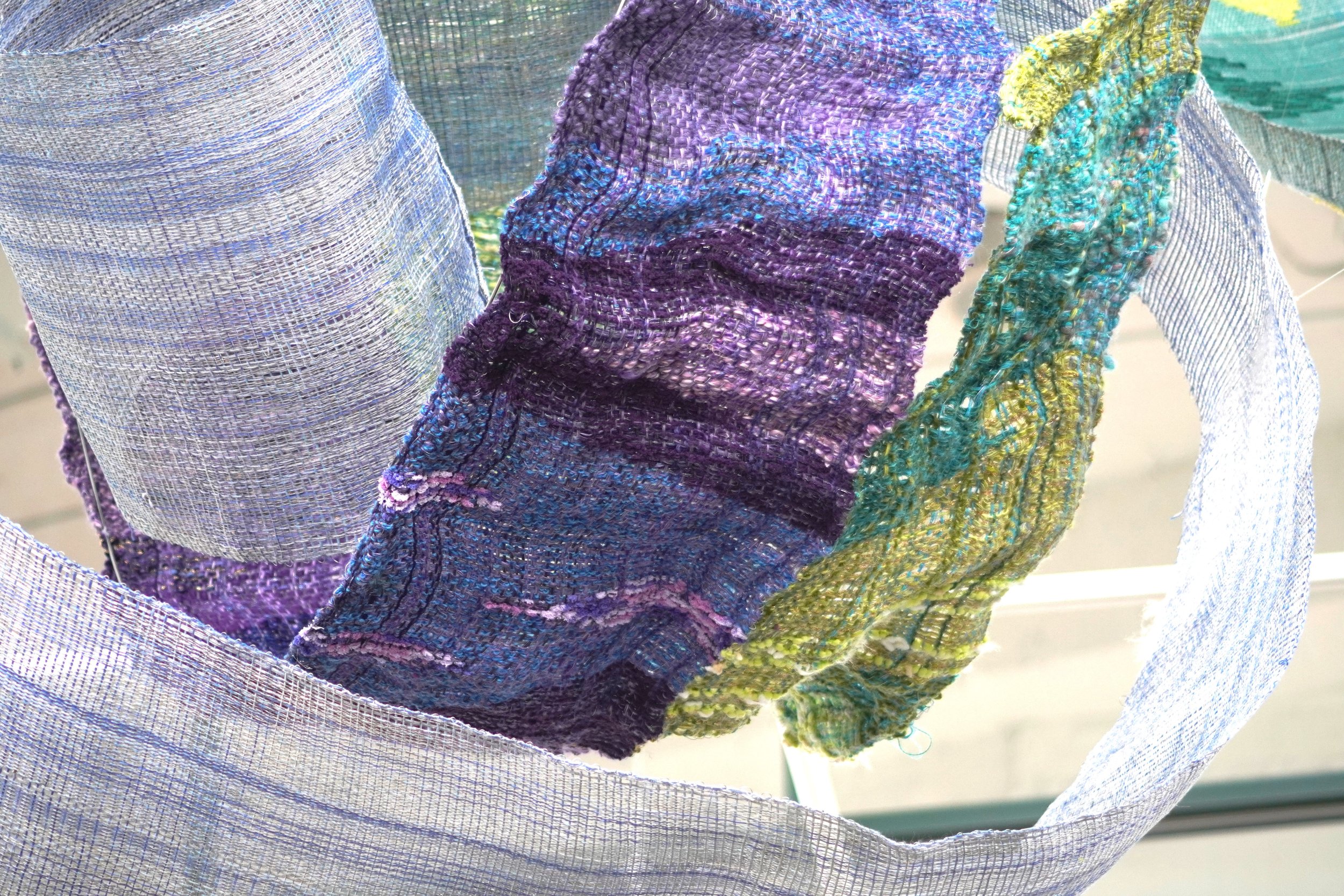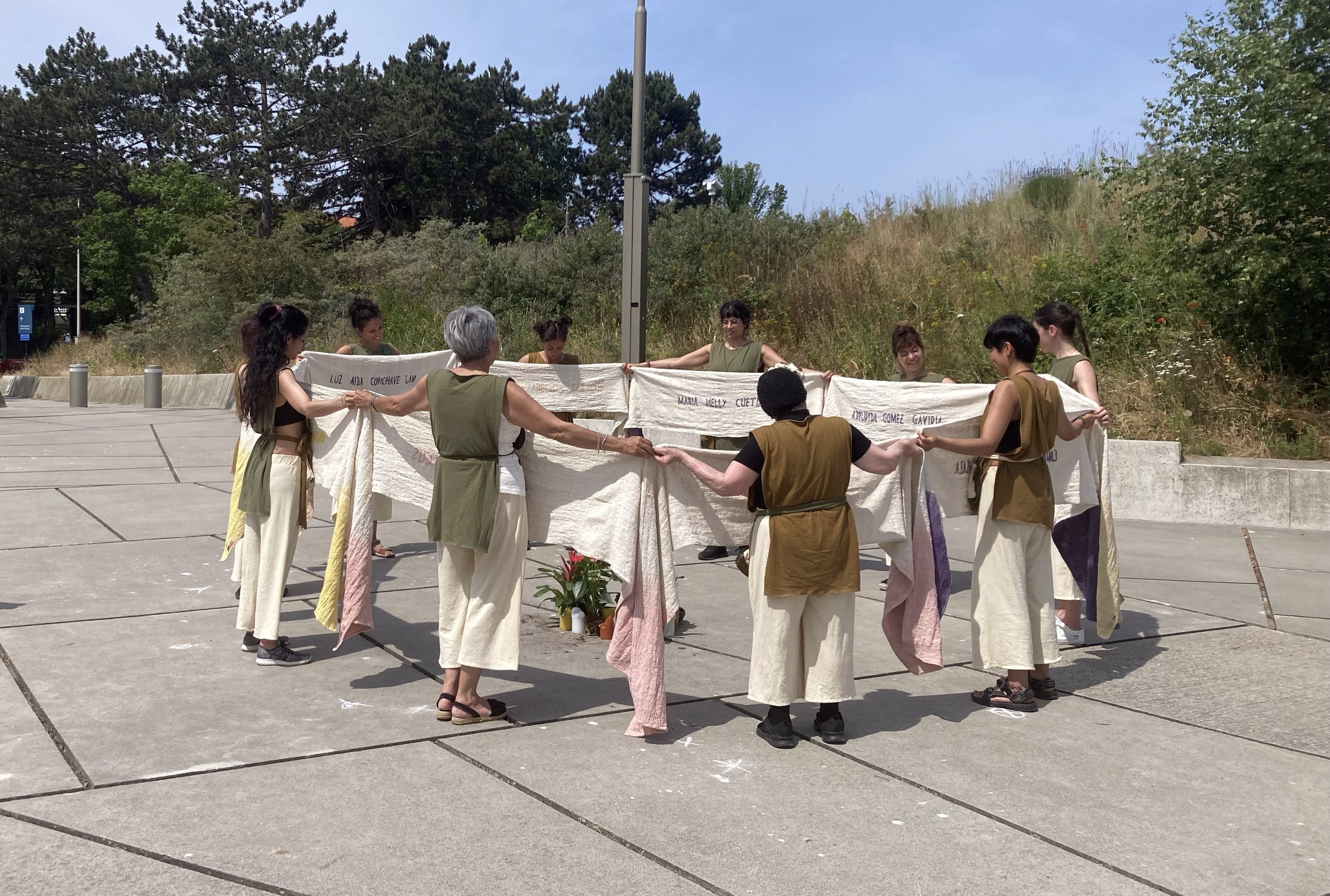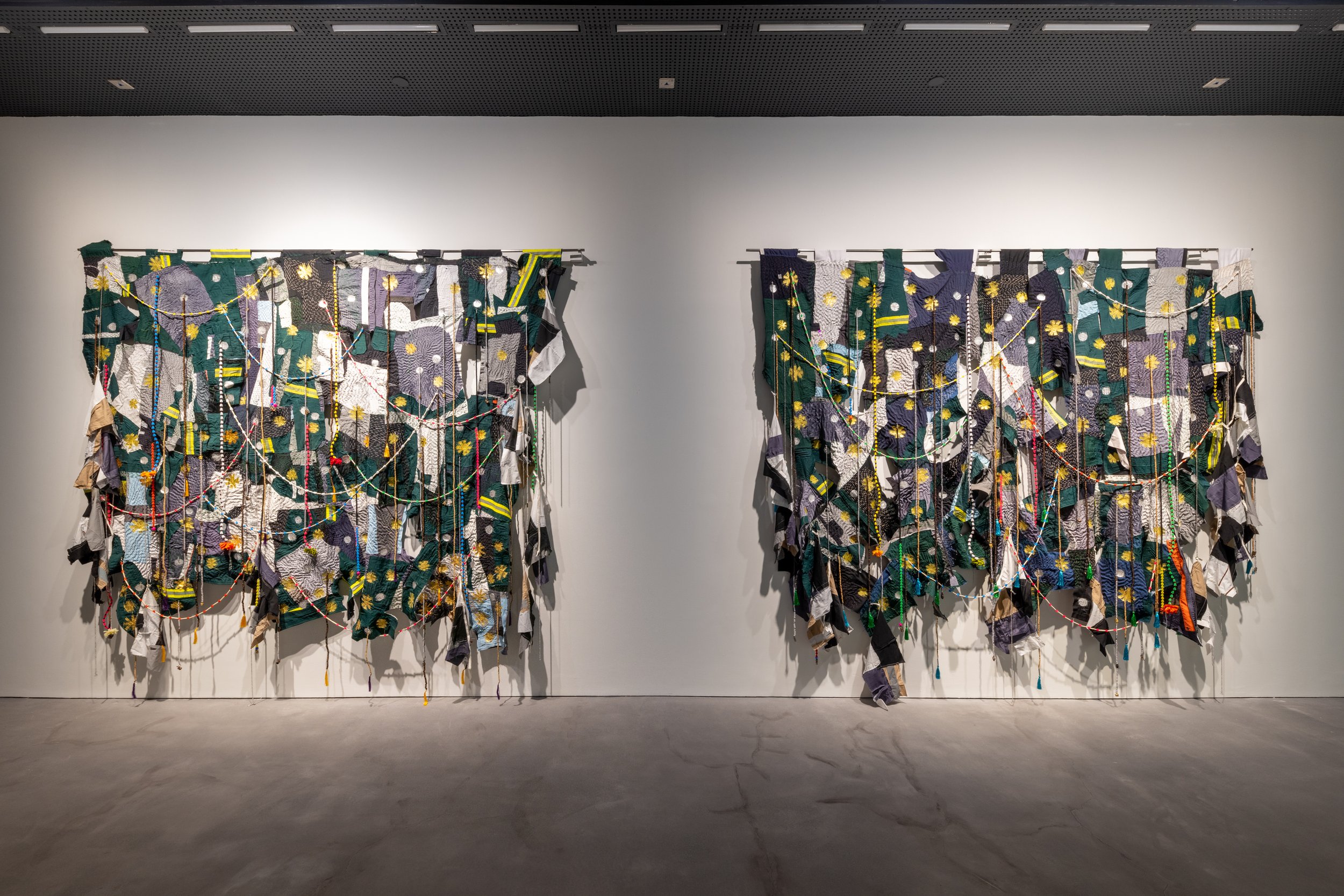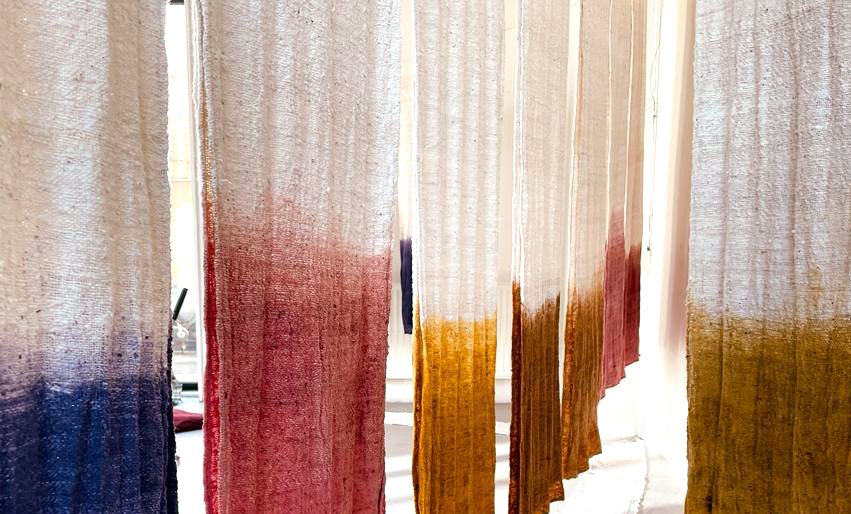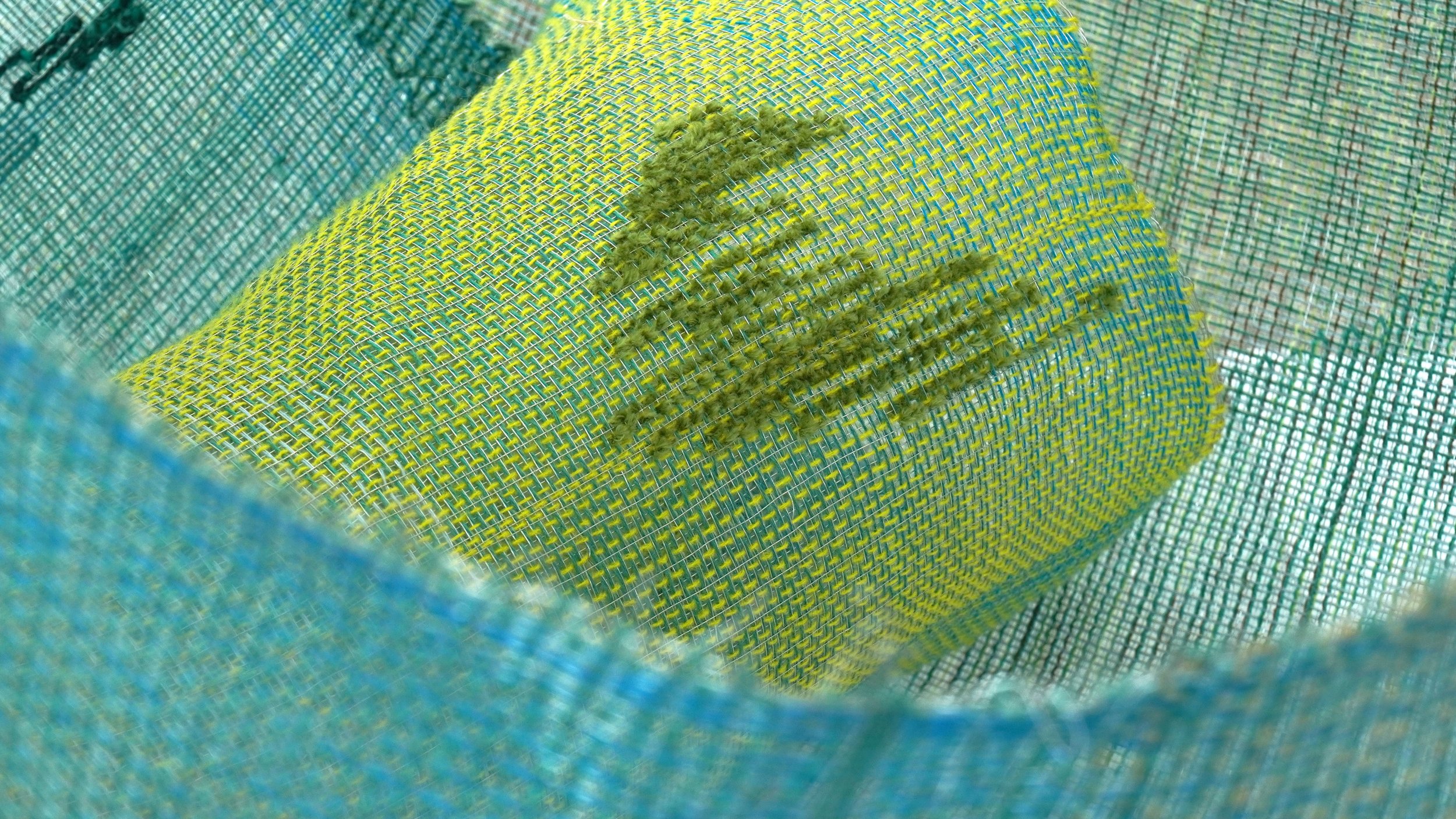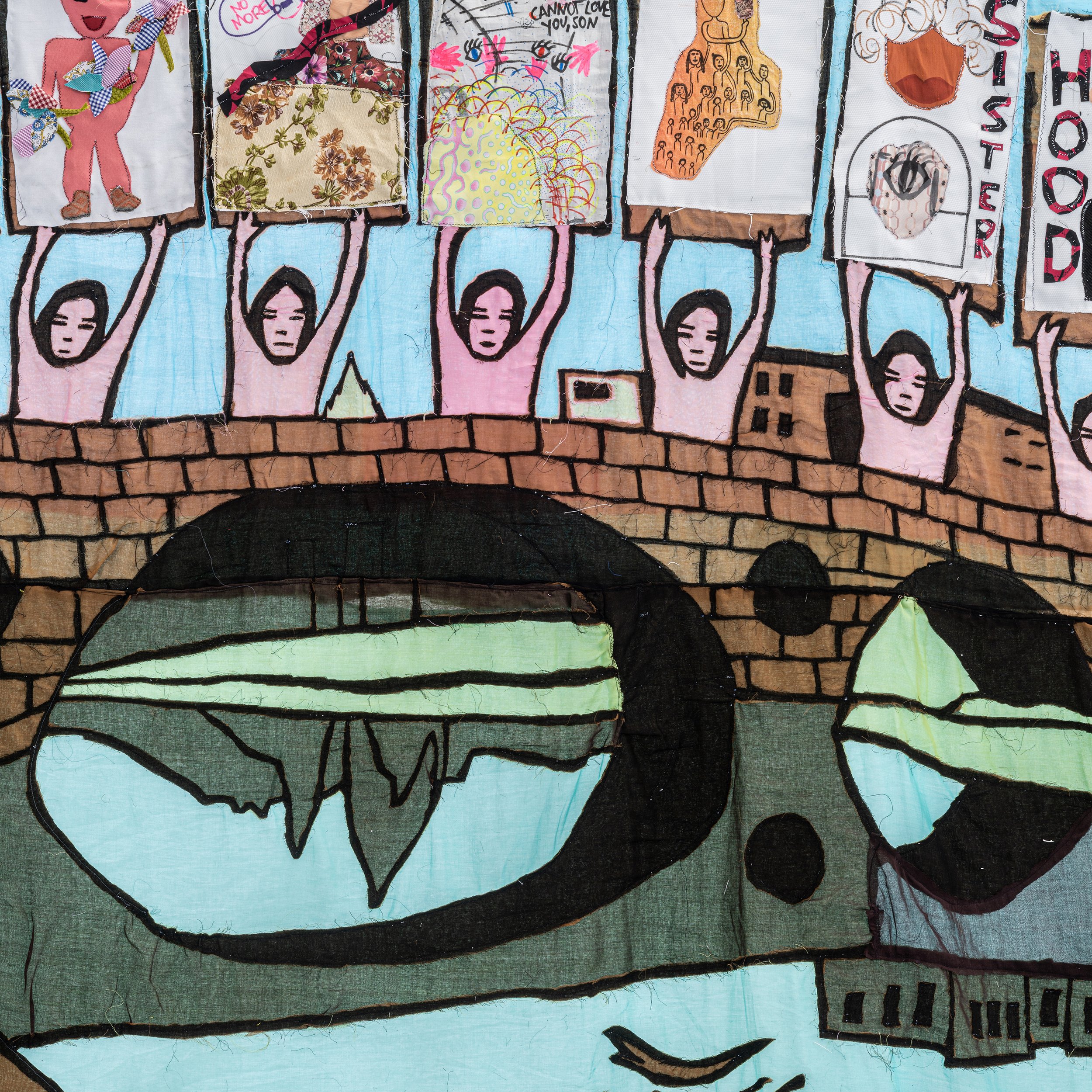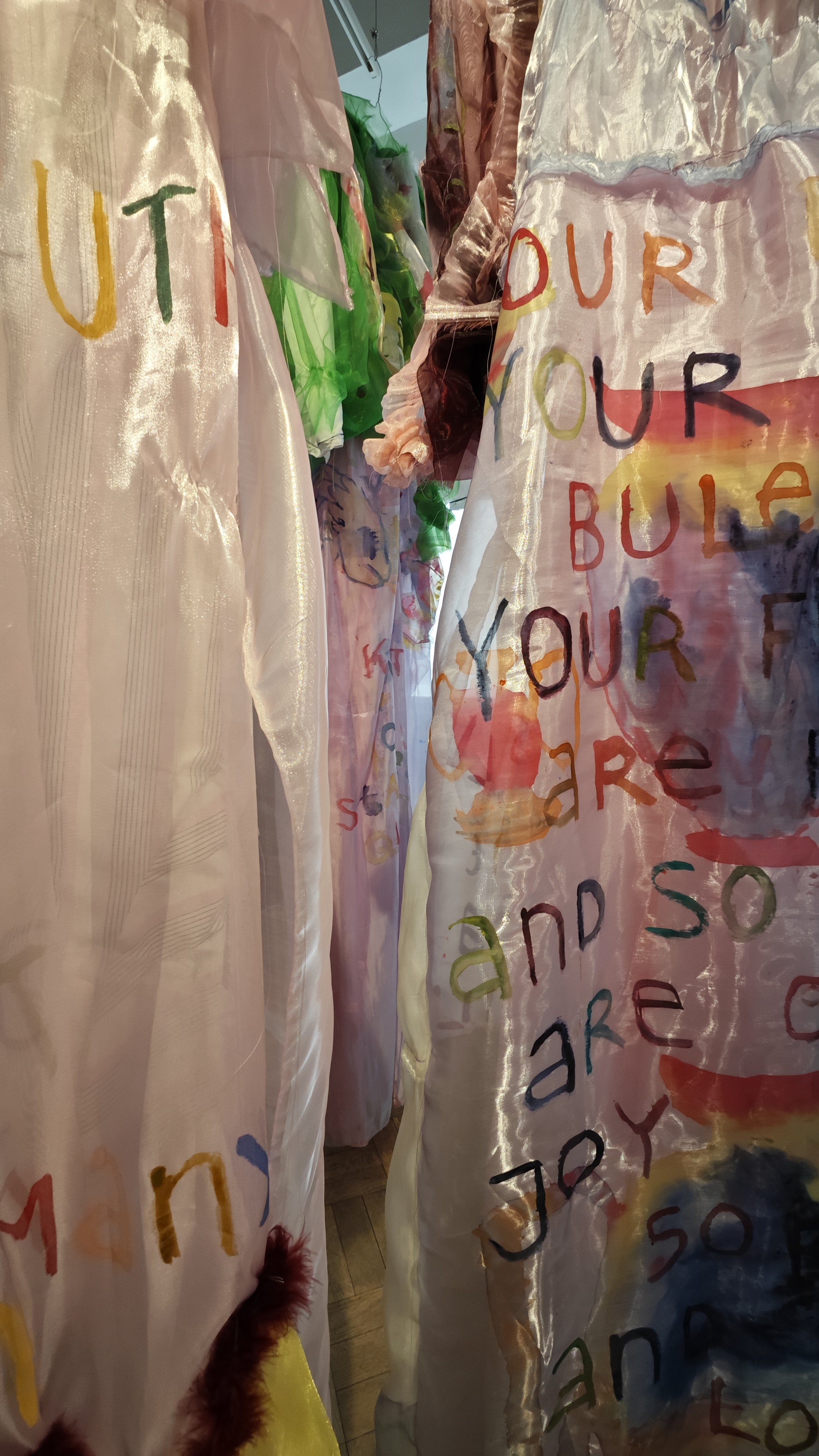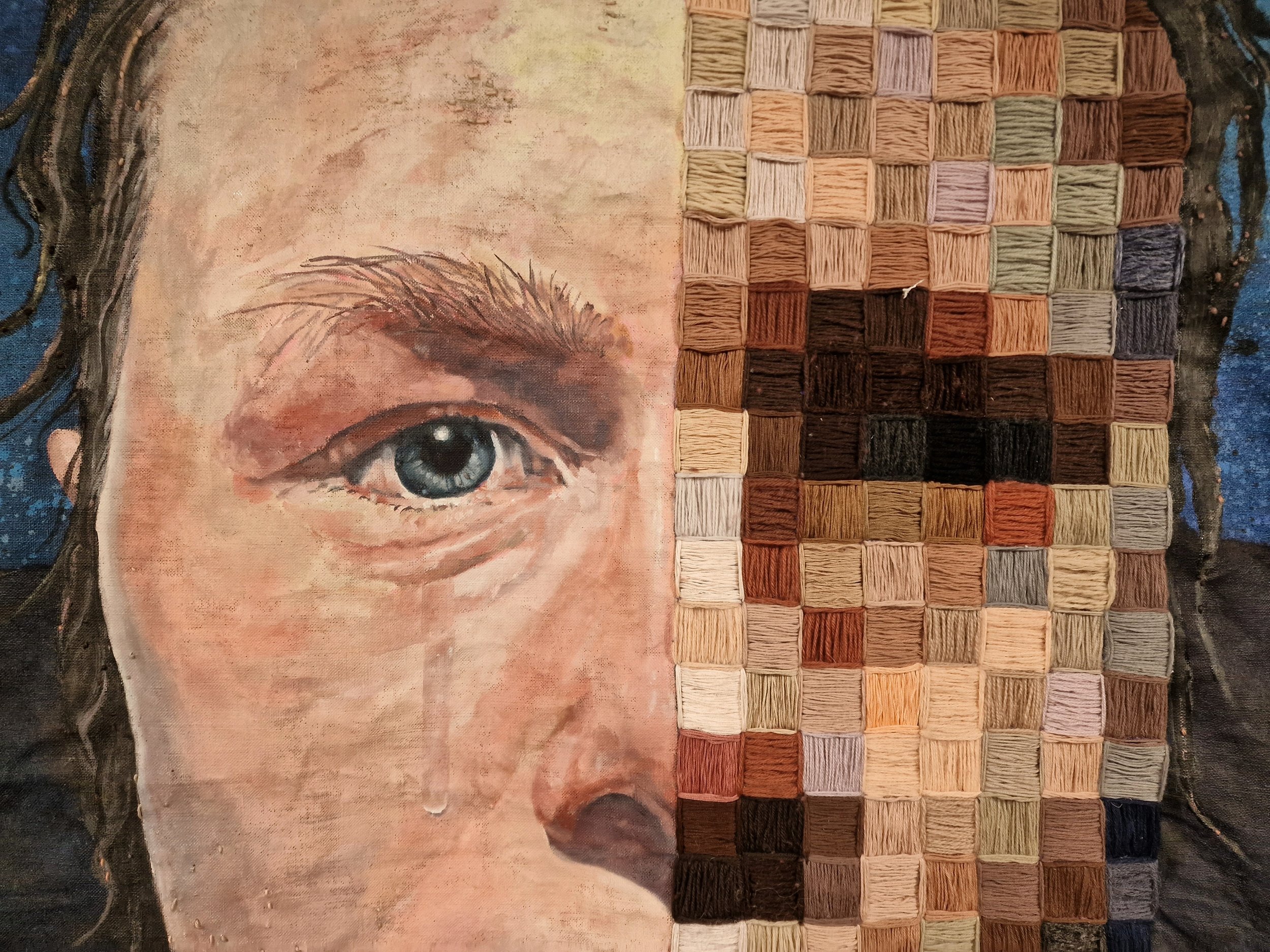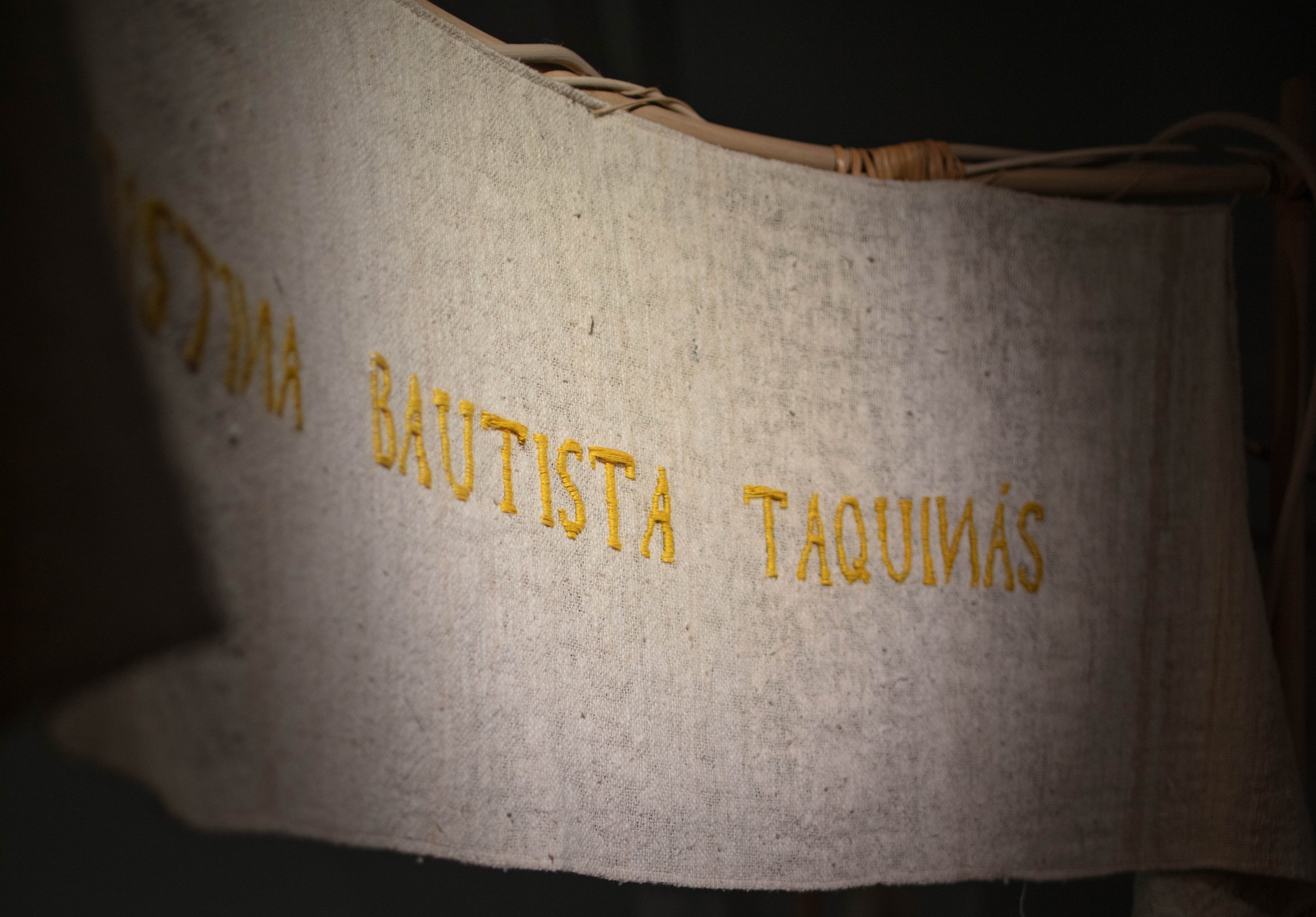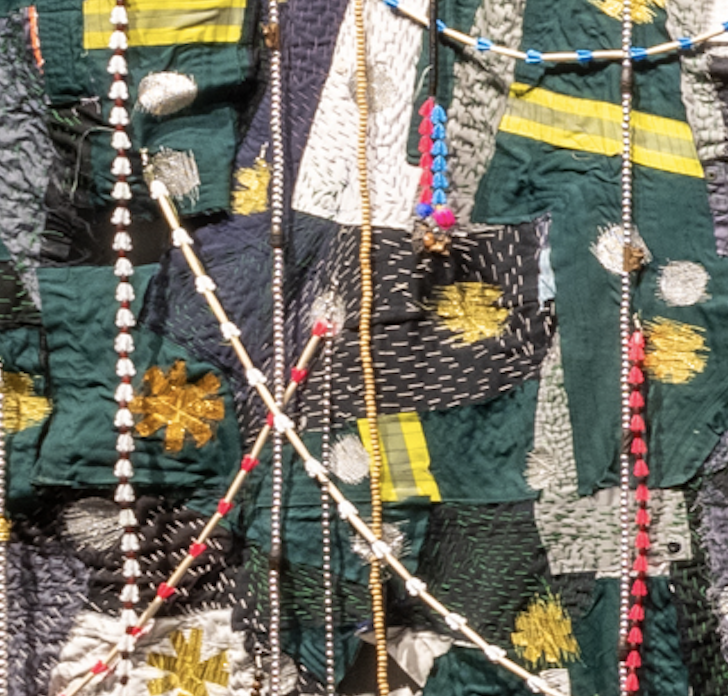Yuma TARU, The Tongue of Cloth, 2021, stainless steel yarn, metal yarn, magnet wire, ramie yarn, wool yarn, cotton yarn, fancy yarns, 250 x 500 x 500 cm
Photo courtesy of the artist
Yuma TARU, The Tongue of Cloth (detail), 2021, stainless steel yarn, metal yarn, magnet wire, ramie yarn, wool yarn, cotton yarn, fancy yarns, 250 x 500 x 500 cm.
Photo courtesy of the artist
Anna Torma, MS / Red Fragments, 2017, hand embroidery and sewing, found objects, elements of traditional folk, linen base, 210 × 300 cm.
Photo Norbert Piwowarczyk
22-26.04.2024
Curated by Zoe Yeh, the exhibition Torn and Sutured attempts to examine the thread as a medium for stitching, appropriating medical terms to explore the role of soft and resilient fabrics in healing and resistance.
To be torn means being forcefully separated. In this project, the force causing tearing injuries extends from the physical to the emotional and cultural. The tear could be the painful experiences of diaspora caused by colonialism or postcolonialism in recent history, or the unavoidable separation resulting from ongoing wars.
People continue to repeat history, but no two tears are the same. By examining the pain of others, the exhibition explores the power of textiles as a medium for recording history.
Nominated by Zoe Yeh:
Yuma Taru is an aboriginal Taiwanese Atayal artist. In the past, weaving was an essential skill for Atayal women. However, this cultural practice suffered a rupture due to the assimilation policies during the colonial period. The Atayal people's weaving tools were taken away, and their sturdy hemp fabric was used to make military uniforms.
Determined to revive the lost tradition, Taru embarked on extensive research that spanned decades. Through interactions with tribal elders, literature analysis and studying museum collections, she gradually reconstructed the Atayal weaving techniques and established a learning system. The series the tongue of cloth symbolises the elders’ wish to use language, a ‘soft’ medium, to continue the strong weaving legacy. Taru also uses stainless steel yarn and magnet wire to weave in an innovative narrative.
Nominated by Central Museum of Textiles:
Anna Torma`s installation Red Fragments is a reference to traditional Hungarian pillow cases (the pattern and red embroidery are typical of the culture of Transylvania), which the artist has cut out and sewn together with pieces of quilt featuring characteristic North American motifs.
The piece is one of the artist’s mother post-stroke attempts to relearn embroidery and overcome limitations imposed by disease. It features an assortment of indistinct, disorganised shapes and figures representing the information chaos that makes it hard to decide what is worth saving and what needs to be discarded in the context of culture and tradition.
Textiles heal wounds, physically and mentally
Surgical sutures, commonly known as stitches, are used to hold body tissues together and close wound edges after an injury or surgery. Suturing a wound requires a thread and a needle, but stitching the wounds of forced separation and time’s passage demands different narrative abilities and creative expressions.
Inspired by the unique qualities of fabric as a medium, this exhibition leverages various metaphors and imaginations at its core.
Nominated by Bukola Oyebode:
If we remain silent is a feminist decolonial anti-monument by Ana Bravo-Pérez, remembering women leaders fighting against environmental injustice in Abya Yala, a South American territory renamed in the 1980s. The title of the project comes from a statement by the late Cristina Bautista Taquinás, an indigenous social leader from Colombia, during a demonstration in October 2019, the day before she was assassinated.
The project includes the following textile-based Minga activities: Healing Colors, Embroidering For Our Sisters and Bodily Remembering. Through textile dyeing and embroidering activities, performance and installation, a memorial emerges for the indigenous, Afro-Colombian and other women social leaders and environmentalists who lost their lives while defending their lands.
Nominated by Hilde Skancke Pedersen:
The young international artist Terje Grimen lives in Norway and works there and abroad, as well as in Sápmi. Sápmi is the area in northern Norway, Sweden, Finland and Russia inhabited by the indigenous Sami people.
The artist focuses on international solidarity and activism, and has involved himself in Sami activism by expressing the Sami struggle against the establishment in his art. The work is based on a photo taken by the artist of one of the activists protesting against the dumping of toxic mining waste in the Repparfjord in Sápmi. The title of the work is the moment when the photo was taken. He asked the activist to close her eyes and listen to the wind, and when she opened them a tear ran from her right eye, a pure tear of sorrow, pain and frustration over the destruction and loss of nature.
The artist went on to create a hybrid textile work of painting and embroidery.
Ana Bravo Pérez, If we remain silent, 2023. (detail installation)
Textile installation consisting of 16 organic cotton textiles, embroidered names with organic linen, ratan sculptural installation created with Monica Mays, and soil at Casco Art Institute: Working for the Commons, Utrecht. Dimensions variable. Courtesy of the artist. Photo: Chun-Yao Lin
Ana Bravo Pérez, Bodily remembering, 2023. Ritual performance with women from the diasporas of Abya Yala holding embroidered textiles in front of the International Criminal Court in The Hague. Courtesy of the artist. Photo: Joram Kraaijeveld.
Terje Grimen, Repparfjorden 22:45 -22.08.2021, 2021, 2 x 3 m. Collaborative work of Tegson And Seasámi activist. Photo by Mihaly Stefanovicz.
Güneş Terkol, Bridge the Gap, 2020, sewing on fabric, 188 x 271 cm.
Realized after a workshop held at Centro Pecci, in collaboration with Centro Antiviolenza La Nara.
Courtesy the artist and Centre Pompidou. Photos: OKNO studio
Sara Rahbar, I Will Love You in the Rain, the Snow, and in the Hail / Flag #58, (Flag series), 2018. Mixed media assemblage.
Jakkai Siributr, HK/T20 and T/HK20, 2023
Afra Eisma, Warrior Garments, 2023, organza, silk, watercolour, silk ink, and thread. Installation shot of Splashdown Tender, solo exhibition at Tetley Museum, Leeds, UK, 2023. Photo: Jules Lister. Image courtesy of The Tetley Museum and No Man’s Art Gallery.
thread as a medium to examine the healing and resistance qualities of fabrics
Torn and Sutured explores different causes of tearing injury, from physical to emotional and cultural, like diaspora and warfare.
Nominated by Lottozero:
Güneş Terkol's textile banners are collective artworks which involve female communities in finding a free space for self-expression, where the practice of sewing, freed from domestic connotations, takes on new possible meanings.
Bridge the Gap was realized after a workshop with a group of women guests of Centro Antiviolenza La Nara in Prato, for the exhibition Protext! When fabric becomes a manifesto, held at Centro Pecci in 2020. Made during the Covid emergency, the feminist banner portrays this community of women in a moment of spatial and temporal suspension: a bridge between the past present and future on which to pause to give substance to their voices: sewn onto other banners are their life stories, dreams, expectations, values of solidarity and sisterhood.
Nominated by Caroline Kipp:
Artist Sara Rahbar left her birthplace in Iran during the immense upheaval that followed the revolution in 1979 and the start of the Iran-Iraq war in 1980. Assembled from Iranian textiles and an American flag, I Will Love You in the Rain, the Snow, and in the Hail / Flag #58 represents how the artist’s identity has been shaped by cultural belonging, nationalism, and war. Embroideries, weavings, and ornaments were diligently collected and combined on top of the U.S. flag until only the iconic stars remained visible, a metaphor for piecing a life together through the traumas of war and displacement in a new, foreign country. Rahbar’s fragmented, poetic titles express the romanticized, joyful memories that exist alongside painful ones when she recalls her homeland.
Nominated CHAT (Centre for Heritage, Arts and Textile):
The COVID-19 pandemic has shed light on a myriad of social issues around the world. In particular, the massive economic disruptions have amplified existing inequalities in society.
Jakkai Siributr actively sought to alleviate the financial strain on workers made redundant during the pandemic, such as by purchasing their old uniforms for his art creation. HK/T20 and T/HK20 comprise uniforms collected from people in Hong Kong and Thailand who suffered from the negative impact of COVID-19 in the past few years. Some of these people changed to painting houses after losing their jobs in retail due to a decline in tourist numbers; others had to work longer hours to disinfect buildings. There were also security guards who had to work with half the usual number of staff.
Nominated by TextielMuseum:
Anger and vulnerability can be a source of strength, hope, and power. In her Warrior Garments, Afra Eisma translates her anger at the condition of the world and women’s place in it into bright, frilly, feminine suits of armor. By creating easily approachable, tactile textile works, Eisma aims to open conversations around difficult and painful topics like social injustice, institutional violence, and inequality.
Eisma creates these dresses by painting phrases of her “anger speech” onto silky fabric and stitching it into colorful dresses, thus creating garments which hold space for both safety and pain. The soft fabric which covers the wearer’s body holds messages of vulnerability and anger, forming a protective layer which catalyzes hope for change.
THE CURATOR
Zoe Yeh is the director and curator of the Honggah Museum, Taipei. She studied Curating and Cultural Production in the Graduate Institute of Trans-disciplinary Arts of National Taipei University of the Arts.
Yeh has actively contributed to the local arts community and hosted various participatory projects. Besides the museum’s textile collection, Yeh also spearheads research on Taiwanese video artists and has co-curated the 8th Taiwan International Video Art Exhibition-Living Togetherness.
Zoe Yeh
Textile Culture Net is co-funded by the European Union. Grant Agreement n°101099994



